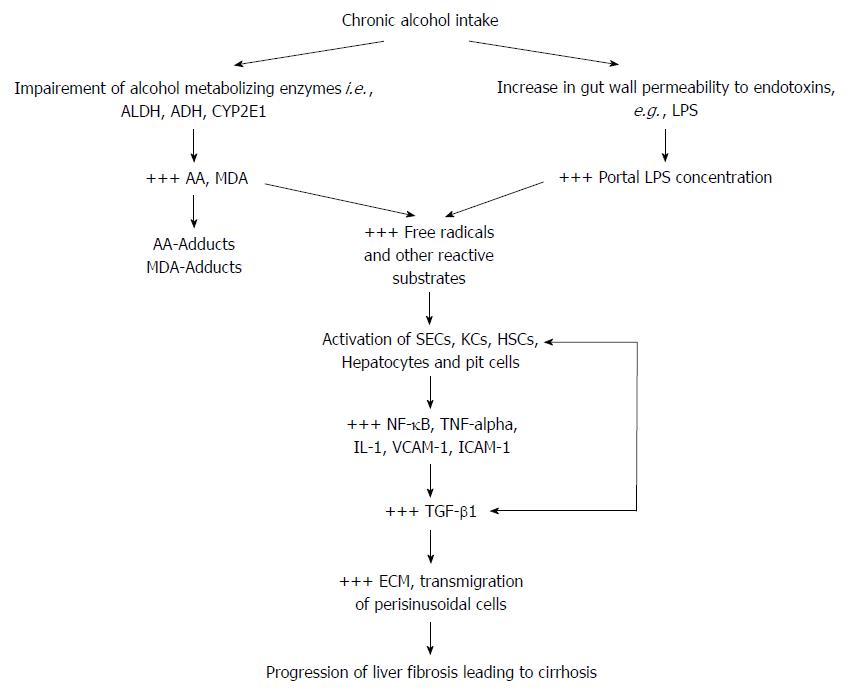Copyright
©The Author(s) 2016.
World J Gastroenterol. Jan 7, 2016; 22(1): 50-71
Published online Jan 7, 2016. doi: 10.3748/wjg.v22.i1.50
Published online Jan 7, 2016. doi: 10.3748/wjg.v22.i1.50
Figure 2 A schematic illustration of the two-way attack of hepatic cells in alcoholic liver disease and fibro-hepatocarcinogenesis.
By multiple mechanisms alcohol metabolizing enzymes and gut-derived LPS induce production of free radicals which stimulate the release of pro-inflammatory and pro-fibrogenic cytokines. Free radical-dependent activation of hepatic cells leads to the release of pro-inflammatory transcription factor (NF-κB) and inflammatory cytokines (TNF-α, IL-1β) which provide the signal for injurious overt hepatic inflammatory response. Secondary to the injurious hepatic inflammatory response, is the activation of hepatic cells (mainly HSCs and KCs) to further release pro-fibrogenic factors, mainly the key fibrogenic cytokine (TGF-β) which mediates a high ECM turnover (increased fibrogenesis : fibrinolysis ratio) in HSCs and the space of Disse, and trans-migration of hepatic non-parenchymal cells. These pathological events initiate liver fibrosis and cirrhosis leading to fibro-hepatocarcinogenesis. AA: Acetaldehyde; ADH: Aldehyde dehydrogenase; ALDH: Alcohol dehydrogenase; ECM: Extracellular matrix; HSCs: Hepatic stellate cells; IL-1β: Interleukin-1 beta; KCs: Kupffer cells; LPS: Lipopolysaccharide; MDA: Malondialdehyde; NF-κB: Nuclear factor kappa B; SECs: Sinusoidal endothelial cells; TGF-β: Transforming growth factor beta; TNF-α: Tumor necrosis factor alpha; VCAM: Vascular cell adhesion molecule; +++: Up-regulated expression or overproduction.
- Citation: Boye A, Zou YH, Yang Y. Metabolic derivatives of alcohol and the molecular culprits of fibro-hepatocarcinogenesis: Allies or enemies? World J Gastroenterol 2016; 22(1): 50-71
- URL: https://www.wjgnet.com/1007-9327/full/v22/i1/50.htm
- DOI: https://dx.doi.org/10.3748/wjg.v22.i1.50









